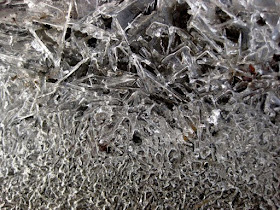"An unusual property of ice frozen at atmospheric pressure is that the solid is approximately 8.3% less dense than liquid water. The density of ice is 0.9167 g/cm3 at 0 °C,[6] whereas water has a density of 0.9998 g/cm3 at the same temperature. Liquid water is densest, essentially 1.00 g/cm3, at 4 °C and becomes less dense as the water molecules begin to form the hexagonal crystals[7] of ice as the freezing point is reached. This is due to hydrogen bonding dominating the intermolecular forces, which results in a packing of molecules less compact in the solid. Density of ice increases slightly with decreasing temperature and has a value of 0.9340 g/cm3 at −180 °C (93 K).[8]"
"Ih = Normal hexagonal crystalline ice. Virtually all ice in the biosphere is ice Ih, with the exception only of a small amount of ice Ic."
From Science Learning Lab:
"Molecules are constantly moving because they have energy. In a liquid form, water molecules have more energy than in a solid – they move around quickly, essentially bouncing off of one another. As the liquid cools down, the amount of potential energy is reduced and the molecules start to move slower. When the water temperature reaches around 0°C, the molecules stick together and form a solid – ice. Even in this solid stage, the molecules are still moving – we just can’t see it."
From NYU:
"In ice Ih, each water forms four hydrogen bonds with O---O distances of 2.76 Angstroms to the nearest oxygen neighbor. The O-O-O angles are 109 degrees, typical of a tetrahedrally coordinated lattice structure. The density of ice Ih is 0.931 gm/cubic cm. This compares with a density of 1.00 gm/cubic cm. for water.
There are eleven different forms of crystalline ice that are know. The hexaganol form known as ice Ih is the only one that is found naturally. The lattice structure of ice 1h is shown here."




No comments:
Post a Comment
Comments will be reviewed, not for content (except ads), but for style. Comments with personal insults, rambling tirades, and significant repetition will be deleted. Ads disguised as comments, unless closely related to the post and of value to readers (my call) will be deleted. Click here to learn to put links in your comment.